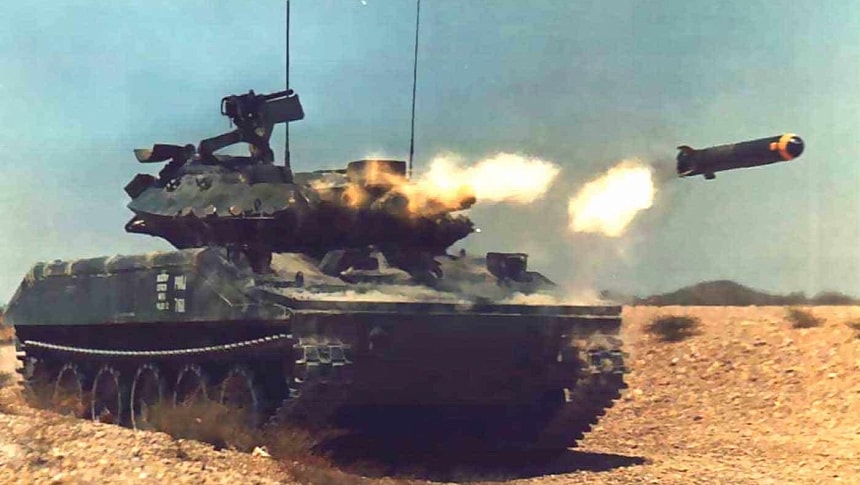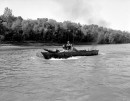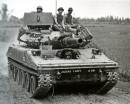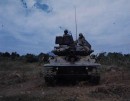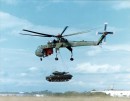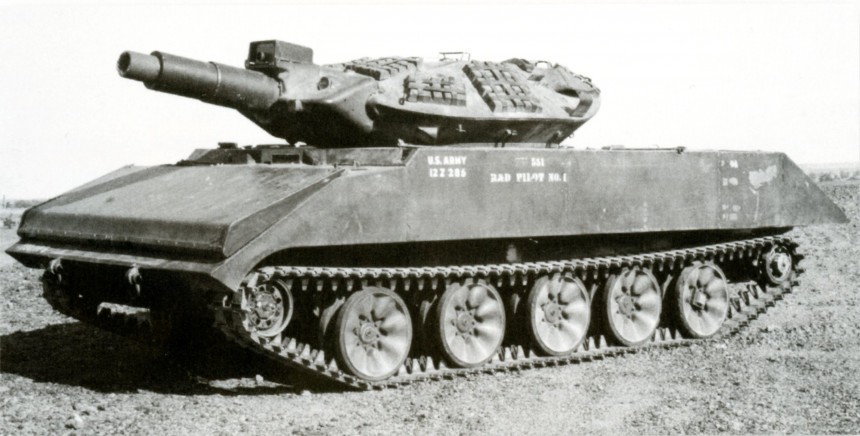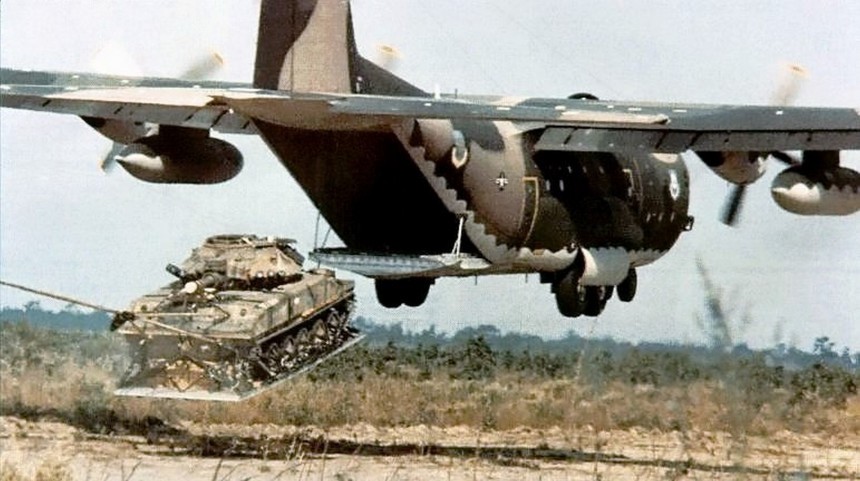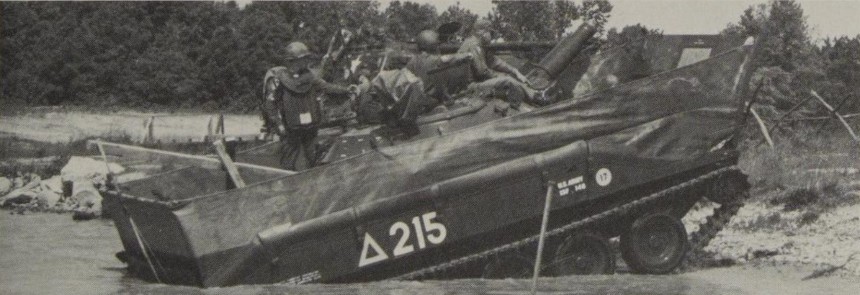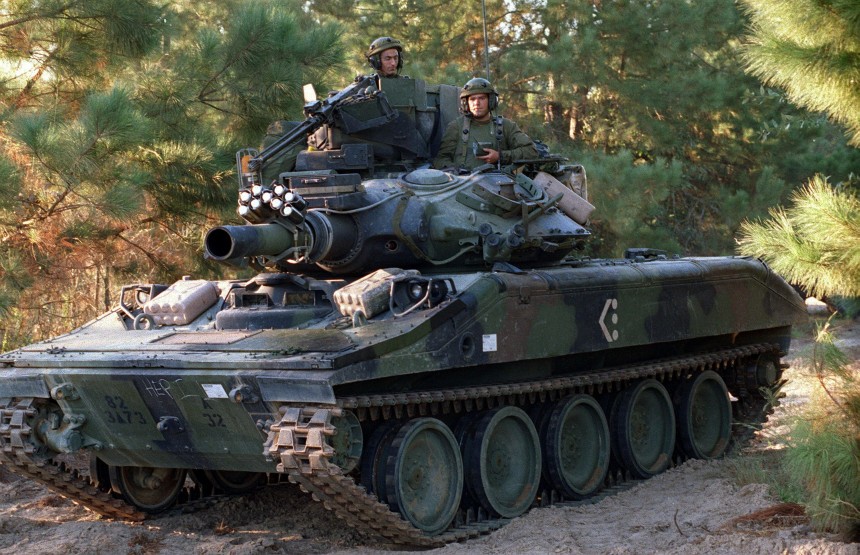What makes a tank a failure? Does it have to have a drivetrain so unreliable you have to carry a spare transmission in the trunk? Does it need to ignite its ammo box and send the turret into low-Earth orbit when even a marginally competent anti-tank weapon hits the hull? Or maybe it's just so darn expensive it bankrupts armies building enough for just a few tank companies?
Well, the amphibious M551 light tank, better known as the Sheridan, wasn't the worst of its kind to enter combat, far from it. Still, it was hardly anything to write home about most of the time, with a few exceptions. For a tank that only left service around a quarter century ago, hardly anyone outside of hardcore tank enthusiast circles remembers the Sheridan. In a country that even 50 years ago spent more on defense than anyone else, a 25-year service record, most of which was spent being made fun of by military analysts, wasn't going to impress anybody.
In truth, the US Army has always had a love-hate relationship with light tanks. The first American tank to be mass-produced was a license-built adaptation of the French Renault FT light tank that saw action during World War I. During the inter-war years, American manufacturers of war machines gradually transitioned away from license-built copies of foreign designs in favor of wholly bespoke domestic hardware. Light tanks would begin the slow transition away from being front-line combat vehicles in favor of more specialized reconnaissance, scout, and support vehicles around this time.
By the dawn of the Second World War, the scope of the American light tank's responsibilities in combat was ready to expand further. Not only were M2s and M3 Stuart bringing the fight across the deserts of North Africa, later joined in Europe by the M24 Chaffee, but a profound increase in performance from cargo aircraft meant that novel airborne-deployed light tanks like the M22 Locust could set the foundation for the role the M551 would usurp years later. However, whatever goodwill the US Army may have had with light tanks during the war would grow sour soon after it ended.
As the power of anti-tank weapons outpaced the damage protection of tank armor, the arrival of main battle tanks (MBTs) like the Soviet T-54 and American M48 Patton meant the bulk of global mechanized armor would gradually shift to heavier chassis with greater armor protection and firepower, further cementing the light tank's place outside of front-line combat in most cases. In the meantime, you wouldn't believe who was called upon to build the next generation of post-war American light tanks.
Under the same corporate umbrella as the first-gen Eldorado and the timeless classic Series 75, the Cadillac-designed M41 Walker Bulldog was the next attempt at the quintessential American light tank. With its 25 mm of frontal armor and a 500-horsepower air-cooled boxer engine, almost like a Porsche 911, the Walker Bulldog is probably most well-known for failing to secure a key Cuban airfield during the disastrous Bay of Pigs Invasion, despite some impressive combat against Cuban T-34s.
While not a bad light tank, the Walker Bulldog was not the kind of armored vehicle destined for a half-century service history like more famous designs from the period. Its paltry cruising range and heavy-set demeanor for a light tank meant the Walker Bulldog wasn't going to fare very well in the wars the US Army was due to fight, namely in Vietnam. Of course, that didn't stop the South Vietnamese Army from taking orders for a few hundred M41s with very mixed results. Still, work continued by the US Army to find a suitable supplement and eventual replacement for the Walker Bulldog.
Ideally, this new war machine would be an amphibious vehicle. One delivered to an enemy via ship to a beachhead to support a larger sea-to-land assault by wading through the waters to shore before fighting their way into fortified enemy positions further inland. It was a role being perfected at the time in the Soviet Union by the then brand-new PT-76. In short, if US Forces wanted to stage another Normandy-style seaborne invasion of Eastern Russia, Indochina, or lord knows where else, this new light tank would be a vital spearhead. Development began by attempting to fit the same M32A1 rifled cannon from the Walker Bulldog onto a lighter, more agile chassis suited to airborne drops and sea-based amphibious invasions.
This initiative commenced in 1959 and resulted in two prototypes for the AAI T92, an 18-ton light tank equipped with a semi-automatic loader device for its cannon. It foreshadowed the implementation of fully mechanized autoloaders in many modern main battle tanks. Still, it was deemed financially unsuitable to adapt for the amphibious assault. Another design, developed alongside AAI and called the T71, never even got off the drawing board. But on the next go-around, two separate design teams, one four-crewed design from Cadillac and a three-crewed joint venture between AAI, makers of the T92, and Allis-Chalmers, makers of heavy-duty agricultural equipment, went across the desk of the Army.
Both designs were built to the strict weight specifications put in place by the, initially set at ten tons but later upped to 15. Ultimately, It was Cadillac's design, with its more combat-practical three-person turret, was selected to be the first use of a new American anti-tank weapon that blurred the line between a canon and a small missile silo. Though its launch platform was a Cadillac product, the MGM-51 Shillelagh cannon-based anti-tank missile was a Ford of all things. More specifically, the Aeronutronic division of Ford Aerospace, owned by the big-wigs in Detroit who were busy building the second-generation Ford Thunderbird at the time.
Named for a traditional Irish walking (beating) stick and intended for a West German-American main battle tank prototype that was never put into service, Shillelagh missiles were stored inside an armored vehicle just as a normal cannon round would. When locked onto enemy tanks, the missile would be loaded into the barrel of a purpose-built M81 152mm rifled gun launcher that sent the missile down the barrel and toward the target. Meanwhile, a single 50-caliber machine gun acted as the tank's secondary armament.
While the Army waited for the Shillelagh platform to mature enough for deployment, it was decided their new light tank's gun would only fire traditional cannon rounds in the interim. Production began on the M551 in April 1967 at Cadilac's state-of-the-art production facility in the Brook Park neighborhood of Cleveland, Ohio, on the same grounds where B-29 Superfortress bombers were built during World War II. In fact, the Sheridan's predecessor, the Walker Bulldog, was also built in Cleveland. Before long, this novel amphibious light tank would get its name, inspired by the famous Civil War Union General Phillip Sheridan.
But if the old general was aware of the feedback this new machine would soon receive, we bet he'd wished he'd never made it out of the Shenandoah Valley. Or, at least, this was the case at first. Almost as soon as the Sheridan entered operational service with the 63rd Armor Regiment at Fort Ruley in Kansas, the complaints rolled in like the YouTube comments on a sub-par rap music video. During combat exercises meant to familiarize crewmembers with the particulars of the Sheridan before overseas deployment, it was found the M81 gun launcher's barrel could crack along the breech if it was fired too rapidly. This necessitated comprehensive modifications to the M551's barrel as well as the rolled homogeneous steel turret.
But even when the cannon worked correctly, the recoil was so bad it often made the tank buck like a bronco. According to the 'Jane's Pocket Book of Modern Tanks and Armored Fighting Vehicles', the Sheridan's dimensions of 20 feet, eight inches (6.30 m) long and nine feet, two inches wide make it roughly the size of a class 5 or 6 heavy-duty truck. However, with its lightweight 7039 aluminum alloy hull and gross weight of 33,518 Ib (15,276 kg), the M551 didn't weigh much more than a civilian truck.
With General Motors-sourced Detroit Diesel turbo straight six packing 615 lb-ft (830 N⋅m) of torque under Sheridan's rear hatch, a top speed just north of 40 mph (64.3 kph) on the smooth tarmac was achievable, good for between 265 and 300 hp depending on the variant. Not that the M551 would ever go that fast in the warzone it was due to fight in. Army top brass had been hounding the Pentagon to send the Sheridan to the jungles of Vietnam as early as 1966. But it wouldn't be until 1968, when reserves of 152 mm ordnance had reached sufficient levels, that General Creighton Abrams, yes, THAT Abrams, gave the all-clear to send Sheridans to Army Cavalry units. Whether deployed amphibiously from ships or dropped from the air via C-130, C-141, and C-5 cargo planes, Sheridans were on the scene in Indochina.
Nearly all American cavalry units deployed to Vietnam after the M551's deployment utilized the light tank somehow. But it was while in combat against North Vietnamese forces using Soviet equipment that crews found the Sheridan had one particularly catastrophic flaw, the combustible-cased propellant charge on its unguided cannon shells left the tank particularly vulnerable to land mines and rocket-propelled grenade fire. If the hull were to be even marginally breached and the nylon bags covering these rounds exposed to flames, standard operating procedure dictated the crew run screaming out of their tank and get the hell out of dodge as if their lives depended on it.
As many as five M551s were destroyed in one day at points during the conflict in this way, all felled by RPG-7s supplied to the North Vietnamese by the Soviets. But at least the Sheridan didn't get stuck in the loose jungle soil every five minutes like the heavier M48 Patton MBT was famous for doing. In support of US infantry and cavalry units, M551s often served alongside the famous M113 APC, perhaps the most iconic armored vehicle of the conflict, where crews either loved or hated these water-fairing light tanks, depending on the specifics of the mission.
Combat in which the Sheridan was called to fire its Shillelagh anti-tank missile were particularly bothersome, as the intricate and sensitive target acquisition and guidance hardware struggled against the relentless jungle elements. This hardware was a plague on the missile that never fully worked itself out before America's withdrawal from the Vietnam conflict. The US Army's foray into Cambodia in May 1970 proved to be especially brutal for Sheridan crews, forced to contend with relentless onslaughts of land mines and RPGs before withdrawing.
But while the US Army was still in Indochina, field modifications to the M551 platform included fastening sheet steel around the secondary machine gun as a precaution against enemy automatic rifle fire, as well as extra plate armor being welded to parts of the tank's undercarriage, all with mixed results. Not long after the end of the Vietnam War, US Army top brass, namely four-star general Donn A. Starry, was already proposing that the Sheridan be retired. With this in mind, the M551 began a slow-but-sure replacement process as early as the late 1970s, or a touch over a decade since its deployment.
Even so, the Sheridan kept on trucking in background Army and National Guard roles within the well after Vietnam was in the rearview. This included an extended stint with the North Carolina-based 82nd Airborne Division well into the mid-1990s. During the US intervention in Panama from late 1989 to early 1990, Sheridans were secretly snuck into a now-defunct US Air Force Base near the Pacific Ocean entrance to the Panama Canal. From there, M551s proved instrumental to a swift American victory during Operation Just Cause, where its light weight and respectable firepower proved a useful tool of power projection to the Panama Defense Forces.
This was a notion that was replicated not long afterward during the American involvement in the first Gulf War. During Operation Desert Sheild and Desert Storm, a handful of upgraded M551A1s fitted with AN/VVG-1 laser rangefinder for improved weapon accuracy even saw tank-on-tank combat against Soviet-built Iraqi armor. An even smaller group of M551A1 TTS models with the same AN/VSG-2B thermal sight as the M60A3 main battle tank also made a cameo in the conflict. During this time, a new generation of Army tank mechanics grew to appreciate how light on its feet and non-maintenance-heavy the M551 proved to be.
That's especially true compared to the maintenance nightmare that the then brand-new M1 Abrams MBT was becoming. In truth, the mythos surrounding the Sheridan changed dramatically after the initial horror show it displayed in Vietnam. Indeed, it was never going to be an instant icon like the main battle tanks it served alone. But for how much it's ignored in civilian circles, US cavalry and infantrymen of a certain age look back on the Sheridan with an heir of reverence, not repulsion. But was the M551 a "bad" light tank? Well, it probably was in Vietnam, but you'd be surprised how thoroughly it turned things around by the end. And hey, you could always play the Sheridan in War Thunder if that's your thing.
In truth, the US Army has always had a love-hate relationship with light tanks. The first American tank to be mass-produced was a license-built adaptation of the French Renault FT light tank that saw action during World War I. During the inter-war years, American manufacturers of war machines gradually transitioned away from license-built copies of foreign designs in favor of wholly bespoke domestic hardware. Light tanks would begin the slow transition away from being front-line combat vehicles in favor of more specialized reconnaissance, scout, and support vehicles around this time.
By the dawn of the Second World War, the scope of the American light tank's responsibilities in combat was ready to expand further. Not only were M2s and M3 Stuart bringing the fight across the deserts of North Africa, later joined in Europe by the M24 Chaffee, but a profound increase in performance from cargo aircraft meant that novel airborne-deployed light tanks like the M22 Locust could set the foundation for the role the M551 would usurp years later. However, whatever goodwill the US Army may have had with light tanks during the war would grow sour soon after it ended.
As the power of anti-tank weapons outpaced the damage protection of tank armor, the arrival of main battle tanks (MBTs) like the Soviet T-54 and American M48 Patton meant the bulk of global mechanized armor would gradually shift to heavier chassis with greater armor protection and firepower, further cementing the light tank's place outside of front-line combat in most cases. In the meantime, you wouldn't believe who was called upon to build the next generation of post-war American light tanks.
While not a bad light tank, the Walker Bulldog was not the kind of armored vehicle destined for a half-century service history like more famous designs from the period. Its paltry cruising range and heavy-set demeanor for a light tank meant the Walker Bulldog wasn't going to fare very well in the wars the US Army was due to fight, namely in Vietnam. Of course, that didn't stop the South Vietnamese Army from taking orders for a few hundred M41s with very mixed results. Still, work continued by the US Army to find a suitable supplement and eventual replacement for the Walker Bulldog.
Ideally, this new war machine would be an amphibious vehicle. One delivered to an enemy via ship to a beachhead to support a larger sea-to-land assault by wading through the waters to shore before fighting their way into fortified enemy positions further inland. It was a role being perfected at the time in the Soviet Union by the then brand-new PT-76. In short, if US Forces wanted to stage another Normandy-style seaborne invasion of Eastern Russia, Indochina, or lord knows where else, this new light tank would be a vital spearhead. Development began by attempting to fit the same M32A1 rifled cannon from the Walker Bulldog onto a lighter, more agile chassis suited to airborne drops and sea-based amphibious invasions.
This initiative commenced in 1959 and resulted in two prototypes for the AAI T92, an 18-ton light tank equipped with a semi-automatic loader device for its cannon. It foreshadowed the implementation of fully mechanized autoloaders in many modern main battle tanks. Still, it was deemed financially unsuitable to adapt for the amphibious assault. Another design, developed alongside AAI and called the T71, never even got off the drawing board. But on the next go-around, two separate design teams, one four-crewed design from Cadillac and a three-crewed joint venture between AAI, makers of the T92, and Allis-Chalmers, makers of heavy-duty agricultural equipment, went across the desk of the Army.
Named for a traditional Irish walking (beating) stick and intended for a West German-American main battle tank prototype that was never put into service, Shillelagh missiles were stored inside an armored vehicle just as a normal cannon round would. When locked onto enemy tanks, the missile would be loaded into the barrel of a purpose-built M81 152mm rifled gun launcher that sent the missile down the barrel and toward the target. Meanwhile, a single 50-caliber machine gun acted as the tank's secondary armament.
While the Army waited for the Shillelagh platform to mature enough for deployment, it was decided their new light tank's gun would only fire traditional cannon rounds in the interim. Production began on the M551 in April 1967 at Cadilac's state-of-the-art production facility in the Brook Park neighborhood of Cleveland, Ohio, on the same grounds where B-29 Superfortress bombers were built during World War II. In fact, the Sheridan's predecessor, the Walker Bulldog, was also built in Cleveland. Before long, this novel amphibious light tank would get its name, inspired by the famous Civil War Union General Phillip Sheridan.
But if the old general was aware of the feedback this new machine would soon receive, we bet he'd wished he'd never made it out of the Shenandoah Valley. Or, at least, this was the case at first. Almost as soon as the Sheridan entered operational service with the 63rd Armor Regiment at Fort Ruley in Kansas, the complaints rolled in like the YouTube comments on a sub-par rap music video. During combat exercises meant to familiarize crewmembers with the particulars of the Sheridan before overseas deployment, it was found the M81 gun launcher's barrel could crack along the breech if it was fired too rapidly. This necessitated comprehensive modifications to the M551's barrel as well as the rolled homogeneous steel turret.
With General Motors-sourced Detroit Diesel turbo straight six packing 615 lb-ft (830 N⋅m) of torque under Sheridan's rear hatch, a top speed just north of 40 mph (64.3 kph) on the smooth tarmac was achievable, good for between 265 and 300 hp depending on the variant. Not that the M551 would ever go that fast in the warzone it was due to fight in. Army top brass had been hounding the Pentagon to send the Sheridan to the jungles of Vietnam as early as 1966. But it wouldn't be until 1968, when reserves of 152 mm ordnance had reached sufficient levels, that General Creighton Abrams, yes, THAT Abrams, gave the all-clear to send Sheridans to Army Cavalry units. Whether deployed amphibiously from ships or dropped from the air via C-130, C-141, and C-5 cargo planes, Sheridans were on the scene in Indochina.
Nearly all American cavalry units deployed to Vietnam after the M551's deployment utilized the light tank somehow. But it was while in combat against North Vietnamese forces using Soviet equipment that crews found the Sheridan had one particularly catastrophic flaw, the combustible-cased propellant charge on its unguided cannon shells left the tank particularly vulnerable to land mines and rocket-propelled grenade fire. If the hull were to be even marginally breached and the nylon bags covering these rounds exposed to flames, standard operating procedure dictated the crew run screaming out of their tank and get the hell out of dodge as if their lives depended on it.
As many as five M551s were destroyed in one day at points during the conflict in this way, all felled by RPG-7s supplied to the North Vietnamese by the Soviets. But at least the Sheridan didn't get stuck in the loose jungle soil every five minutes like the heavier M48 Patton MBT was famous for doing. In support of US infantry and cavalry units, M551s often served alongside the famous M113 APC, perhaps the most iconic armored vehicle of the conflict, where crews either loved or hated these water-fairing light tanks, depending on the specifics of the mission.
But while the US Army was still in Indochina, field modifications to the M551 platform included fastening sheet steel around the secondary machine gun as a precaution against enemy automatic rifle fire, as well as extra plate armor being welded to parts of the tank's undercarriage, all with mixed results. Not long after the end of the Vietnam War, US Army top brass, namely four-star general Donn A. Starry, was already proposing that the Sheridan be retired. With this in mind, the M551 began a slow-but-sure replacement process as early as the late 1970s, or a touch over a decade since its deployment.
Even so, the Sheridan kept on trucking in background Army and National Guard roles within the well after Vietnam was in the rearview. This included an extended stint with the North Carolina-based 82nd Airborne Division well into the mid-1990s. During the US intervention in Panama from late 1989 to early 1990, Sheridans were secretly snuck into a now-defunct US Air Force Base near the Pacific Ocean entrance to the Panama Canal. From there, M551s proved instrumental to a swift American victory during Operation Just Cause, where its light weight and respectable firepower proved a useful tool of power projection to the Panama Defense Forces.
This was a notion that was replicated not long afterward during the American involvement in the first Gulf War. During Operation Desert Sheild and Desert Storm, a handful of upgraded M551A1s fitted with AN/VVG-1 laser rangefinder for improved weapon accuracy even saw tank-on-tank combat against Soviet-built Iraqi armor. An even smaller group of M551A1 TTS models with the same AN/VSG-2B thermal sight as the M60A3 main battle tank also made a cameo in the conflict. During this time, a new generation of Army tank mechanics grew to appreciate how light on its feet and non-maintenance-heavy the M551 proved to be.
